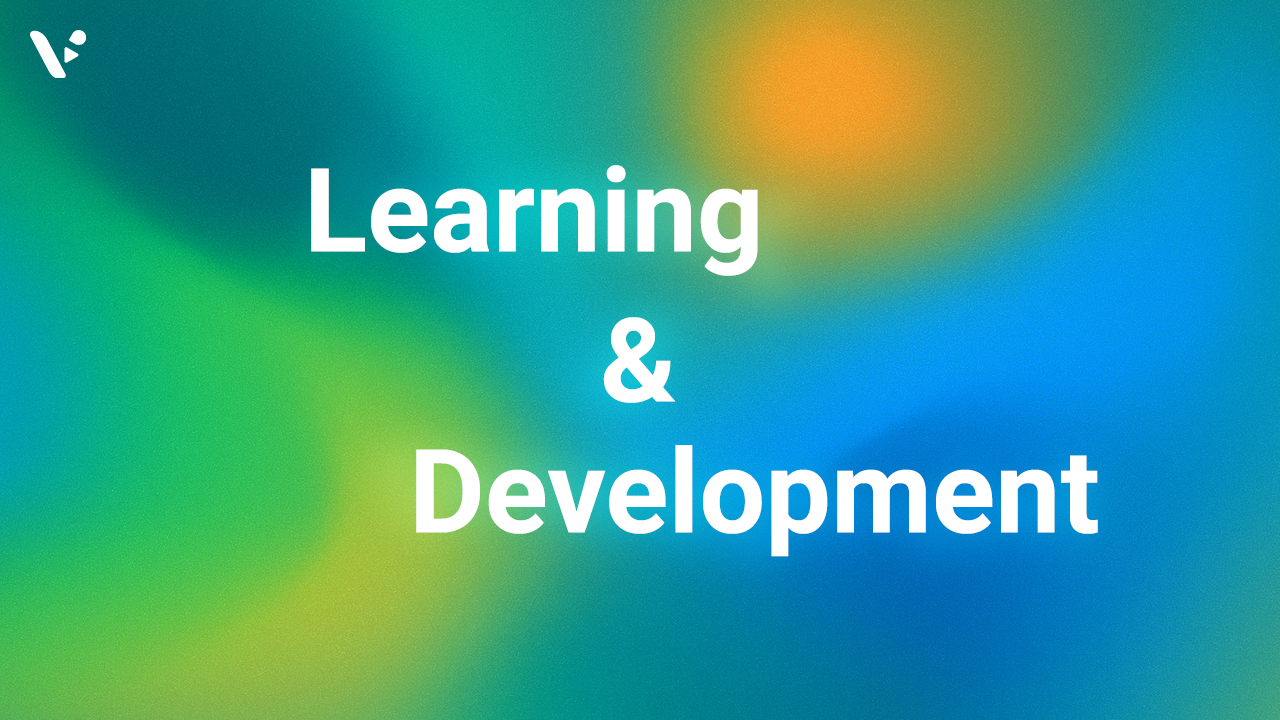Quick answer: What is learning and development?
Learning and development, often shortened to L&D, refers to the processes or oganizations implement to help employees grow their knowledge, skills, and capabilities. It covers everything from onboarding and compliance training to leadership development, technical skill-building, and career advancement. Basically, it’s how businesses ensure their employees are prepared for just about anything.

L&D isn’t just about formal training sessions or e-learning modules, it’s about cultivating a culture of continuous learning. But what exactly does that mean? Ideally, that culture of learning should encourage employees to keep growing and applying what they learn to improve performance and innovation. In modern workplaces, learning happens in many ways: mentorship, stretch assignments, workshops, self-directed learning, and increasingly, through video-based content and collaboration platforms. Put a pin in that last one, as we’ll be discussing video and L&D in more detail soon. What is the scope of a typical learning and development function?
A corporate L&D team typically manages a wide range of responsibilities that go beyond traditional training. Here’s what the function usually includes:
| L&D Function Area | Purpose | Examples |
|---|---|---|
| Learning Strategy & Governance | Align learning initiatives with business goals and priorities. | Annual learning roadmap, capability frameworks |
| Skills and Capability Development | Identify skill gaps and build programs to close them. | Digital fluency training, leadership academies |
| Program Design & Delivery | Develop and deliver learning experiences. | Instructor-led sessions, e-learning, blended learning |
| Performance Enablement | Connect learning to on-the-job application. | Coaching programs, job aids, knowledge bases |
| Measurement & Analytics | Track impact and ROI. | Learning dashboards, engagement metrics, retention data |
| Technology & Platforms | Manage tools that deliver and measure learning. | LMS (Learning Management Systems), video learning tools like Visla |
The modern L&D function also collaborates across departments, partnering with HR, IT, and business leaders to align learning with workforce planning and company strategy.
Why is learning and development important to businesses?
A strong learning and development culture helps businesses stay agile, competitive, and future-ready. In industries that evolve quickly (like technology, marketing, healthcare, or finance), skills can become outdated fast. L&D helps employees keep up with change and adapt their roles to new realities.
But beyond skill-building, L&D plays a direct role in engagement and retention. Employees who feel their employers invest in their growth are more likely to stay. According to LinkedIn’s Workplace Learning Report 2025, companies with a good learning and development strategy have a 57% better retention rate than companies that don’t.
L&D also drives performance improvement. When learning is tied to business goals, employees don’t just complete courses, they apply what they learn to improve processes, innovate, and deliver measurable results.
What impact does a good learning and development strategy have on your business?
When done right, L&D influences multiple areas of business performance:
- Employee Retention: Growth opportunities reduce turnover and build loyalty. LinkedIn’s Workplace Learning Report 2025 has shown us that.
- Innovation: Continuous learning encourages experimentation and creative problem-solving. Studies have shown that more training leads to more innovation.
- Operational Efficiency: Training helps teams adopt new tools and systems faster. Targeted L&D programs can speed up task completion dramatically.
- Leadership Pipeline: Structured learning pathways prepare future leaders. Leadership training not only works, but it works well.
- Customer Experience: Skilled, confident employees deliver better service and solutions. Consistent, high-quality, lengthy L&D programs can noticeably improve customer experience.
The return on investment can be both quantitative and qualitative: improved productivity, reduced hiring costs, and higher morale all feed into a company’s long-term success.
What are some typical learning and development strategies?
Every organization designs its L&D strategy differently, but most combine several key approaches:
- Formal training programs: Structured workshops or digital courses on core skills.
- Blended learning: A mix of self-paced digital content and live instructor sessions.
- On-the-job learning: Stretch projects, job rotations, and shadowing.
- Coaching and mentoring: Personal guidance from experienced leaders.
- Learning in the flow of work: Just-in-time resources or microlearning integrated into daily workflows.
- Video-based learning: Scalable, engaging, and ideal for visual learners.
How to create a learning and development strategy
Building an L&D strategy starts with understanding business goals and translating them into skill priorities. Here’s a step-by-step guide:
- Define business objectives. Start by identifying your organization’s key goals and challenges. What skills or capabilities are most critical to achieving them?
- Assess current skills and gaps. Use surveys, performance data, and skills mapping tools to see where your workforce stands.
- Segment your audience. Not all learners need the same content. Design programs tailored to roles, seniority, or departments.
- Design learning paths. Build structured pathways that move employees from awareness to mastery.
- Choose delivery methods. Combine classroom sessions, e-learning, and social or video-based learning.
- Integrate learning technology. Use an LMS or video creation tool to centralize, deliver, and track learning.
- Measure outcomes. Track participation, behavior change, and business results.
An effective L&D strategy isn’t static. It evolves as business priorities and technologies shift, so continuous evaluation and iteration are key.
How to track the success of your L&D strategy
Tracking learning impact requires moving beyond completion rates. Organizations that measure both participation and performance see clearer ROI. Here are common metrics:
| Metric Type | Description | Example Metrics |
|---|---|---|
| Engagement | Learner activity and satisfaction | Course completion rates, learner Net Promoter Score (NPS) |
| Learning Outcomes | Knowledge or skill gains | Assessment results, skill proficiency scores |
| Behavior Change | Application of learning on the job | Manager observations, project success rates |
| Business Impact | Organizational performance improvements | Sales lift, reduced error rates, faster onboarding |
| ROI | Financial return vs. training investment | Productivity gain per dollar invested |
To make these insights actionable, connect learning data with HR and performance systems. Regular reporting to leadership helps demonstrate L&D’s contribution to growth.
Does video have a place in learning and development?
Video is one of the most effective formats for corporate learning. It’s visual, accessible, and scalable, making it ideal for remote and hybrid teams. Employees can learn at their own pace, revisit content anytime, and engage with materials that feel dynamic and personal.
Why video works for L&D
- Visual storytelling: Complex topics become easier to understand when learners can see examples in action.
- Consistency: Every learner receives the same high-quality message or training.
- Accessibility: Video learning supports multilingual subtitles and playback at different speeds.
- Scalability: One video can reach thousands of employees across time zones.
- Cost efficiency: Record once, reuse endlessly.
How Visla enhances learning through video
Platforms like Visla make it easy for companies to create, edit, and share professional training videos, without needing a production team. L&D professionals can:
- Record training sessions using Visla’s powerful camera and screen recording tools, including smart screen recording and screen step recording.
- Generate instructional videos automatically with the AI Video Agent, transforming text or scripts into polished visuals.
- Collaborate across teams in shared Workspaces and Teamspaces, ensuring consistent branding and centralized feedback.
- Edit faster with scene-based editing and advanced AI-powered editing tools.
- Personalize learning experiences using AI avatars or cloned voices to make content feel relatable and human.
Visla helps L&D teams streamline content creation and keep learning materials current and engaging. Instead of relying on static slide decks or long documents, organizations can build immersive, accessible learning experiences that employees actually enjoy.
FAQ
A true learning and development (L&D) culture turns everyday work into a system for growing capability faster than competitors. Leaders set clear expectations for experimentation, welcome questions, and normalize constructive feedback. Teams share what works through communities of practice and internal forums, which moves knowledge quickly across the company. When people feel safe to speak up and try new approaches, they solve problems sooner, spot risks earlier, and improve products more often. That momentum compounds into better execution, higher customer trust, and stronger employer branding.
A skills‑based organization organizes talent around skills rather than static job titles. L&D becomes the engine that senses skill demand, maps current supply, and closes gaps with targeted pathways. Instead of annual training calendars, the team runs dynamic portfolios tied to high‑value capabilities like data literacy, AI fluency, sales effectiveness, and frontline leadership. Internal mobility accelerates when you connect skills taxonomies to career paths, talent marketplaces, and certification. The result is a workforce that redeploys quickly as priorities shift and a company that treats skills as a core asset.
They’re useful as design heuristics, not as hard rules. 70‑20‑10 reminds designers to balance formal learning with coaching and real work, which usually drives most application. Learning in the flow of work adds just‑in‑time resources, job aids, and micro‑lessons to the moment of need. Treat both ideas as guardrails to build blended journeys where people practice, reflect, and get feedback in context. The aim is not to hit a ratio but to remove friction between learning and doing.
Leaders start with the outcomes that matter and instrument for them from day one. At a minimum, track reach and quality, then add behavior change and business impact such as time‑to‑proficiency, error reduction, cycle‑time improvement, or pipeline velocity. For major investments, calculate ROI and isolate the effect of the program with control groups, comparisons, or contribution analysis. Executive‑level scorecards work best when they combine quantitative metrics with short case narratives that show how capability turned into performance.
Capability academies focus on enterprise‑critical skills end‑to‑end. They combine cohorts, expert‑led practice, scenario simulations, coaching, and on‑the‑job projects to build depth that generic courses rarely achieve. Academies also create shared standards, vocabulary, and tools across functions, which improves collaboration and consistency. Because they operate as ongoing programs instead of one‑off classes, they can adapt curricula quickly as technologies and markets change. Many organizations now use academies to accelerate transformations in areas like digital, customer experience, and operations.

